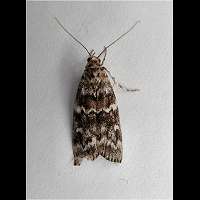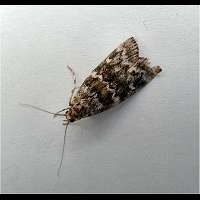Spruce Coneworm Moth Dioryctria abietella
It is not very easy identifying the Spruce Coneworm Moth. The genus it belongs to, Dioryctria, is comprised of a number of species, but as it turns out nobody seems to know exactly how many species there are. Scientists regularly claim to have found new species within this genus, but on the other hand they are also regularly making formerly separate species into one. The matter is so complicated, because even under a microscope the genitals of many species are almost identical. The Spruce Coneworm Moth is similar to the previous species, but it is more lively marked. Especially the striking white zigzag line makes it stand out. Alas, the extremely similar Dioryctria simplicella has the same kind of zigzag line. So, these species are very hard to tell apart. They are even the same size (some 25 to 30mm). Sometimes species much larger than this are seen. Funny thing is that these very big species tend to fly during the day.
The eggs are being laid in summer and the caterpillars feed on pine cones and pine apples. In late autumn the caterpillars are full grown. They fall from the tree to the ground. Then they weave a little web in low vegetation just above the ground. In the web they make a cocon and in it they overwinter.
It is thought the Spruce Coneworm Moth may have two breeds in one year. The first is seen in June and the second from July. On the continent they often appear from June to September and ii is uncertain whether there's only one extended breed or there are two overlapping generations. This species is attracted to light. Common all over England, Wales, Ireland and Sothern Scotland, however usually a rather local species. Common in Europe, most of temperate Asia and Northern America.
This species is also known as the Pine Knothorn Moth.
It is not very easy identifying the Spruce Coneworm Moth. The genus it belongs to, Dioryctria, is comprised of a number of species, but as it turns out nobody seems to know exactly how many species there are. Scientists regularly claim to have found new species within this genus, but on the other hand they are also regularly making formerly separate species into one. The matter is so complicated, because even under a microscope the genitals of many species are almost identical. The Spruce Coneworm Moth is similar to the previous species, but it is more lively marked. Especially the striking white zigzag line makes it stand out. Alas, the extremely similar Dioryctria simplicella has the same kind of zigzag line. So, these species are very hard to tell apart. They are even the same size (some 25 to 30mm). Sometimes species much larger than this are seen. Funny thing is that these very big species tend to fly during the day.
The eggs are being laid in summer and the caterpillars feed on pine cones and pine apples. In late autumn the caterpillars are full grown. They fall from the tree to the ground. Then they weave a little web in low vegetation just above the ground. In the web they make a cocon and in it they overwinter.
It is thought the Spruce Coneworm Moth may have two breeds in one year. The first is seen in June and the second from July. On the continent they often appear from June to September and ii is uncertain whether there's only one extended breed or there are two overlapping generations. This species is attracted to light. Common all over England, Wales, Ireland and Sothern Scotland, however usually a rather local species. Common in Europe, most of temperate Asia and Northern America.
This species is also known as the Pine Knothorn Moth.





